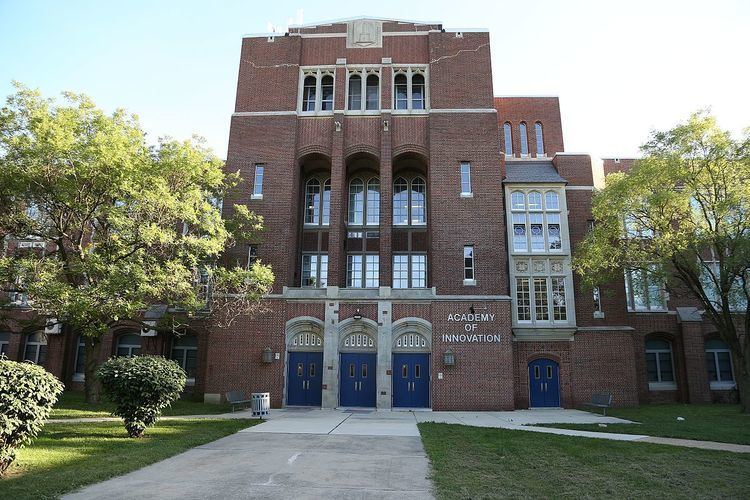Principal Patricia Hunter Mascot The Mighty Ducks | School number 450 Phone +1 410-396-7822 Founded 1883 | |
 | ||
Motto "Continuing the Tradition with Pride, Dignity, and Excellence" Superintendent Sonja Brookins Santelises Address 2301 Gwynns Falls Pkwy, Balti, MD 21217, USA District Balti City Public Schools Similar Edmonds Westside High Sch, Western High School, Mergenth High School, Catonsville High School | ||
Frederick Douglass High School, established in 1883, is an American public high school in the Baltimore City Public Schools district. Originally named the Colored High and Training School, Douglass is the second-oldest U.S. high school created specifically for African American students. Prior to desegregation, Douglass and Paul Laurence Dunbar High School were the only two high schools in Baltimore that admitted African-American students, with Douglass serving students from West Baltimore and Dunbar serving students from East Baltimore.
Contents
Former Supreme Court Justice Thurgood Marshall (1908–1993) is one of Douglass's most notable alumni. After graduating from Douglass in 1926, Marshall went on to college and law school, passing the bar and becoming a lawyer. Representing the NAACP, he successfully challenged school segregation in the landmark Supreme Court case, Brown v. Board of Education (1954). The Supreme Court ruled that segregated, separate but equal, in public education was unconstitutional because it could never truly be equal.
Due to residential segregation and changes in the demographics of Baltimore, as of 2008 the overwhelming majority of students at Douglass were African American and many were poor. It was one of the eleven lowest performing schools in the state of Maryland.
History
Named the "Colored High and Training School," Douglass was founded in 1883 for black students in Baltimore, as the school system was racially segregated. Six years later it moved to a site on East Saratoga Street near St. Paul Street (now developed as present-day Preston Gardens housing). This was near the former Douglass Institute of 1865 and Newton University on East Lexington Street. The new high school was the only one for African-Americans students in the City of Baltimore until Paul Laurence Dunbar High School opened in 1937 off Orleans Street in East Baltimore. At the time, there was also emphasis on training for industrial jobs.
On June 22, 1894, Frederick Douglass gave a commencement address at what would become a namesake school, saying:
"The colored people of this country have, I think, made a great mistake, of late, in saying so much of race and color as a basis of their claims to justice, and as the chief motive of their efforts and action. I have always attached more importance to manhood than to mere identity with any variety of the human family..." "We should never forget that the ablest and most eloquent voices ever raised in behalf of the black man’s cause were the voices of white men. Not for race, not for color, but for men and for manhood they labored, fought, and died. Away, then, with the nonsense that a man must be black to be true to the rights of black men."
In 1900, the school moved from East Saratoga Street to a building on the corner of Dolphin Street and Pennsylvania Avenue.
In 1900 the Baltimore City Public School System had initiated a one-year training course for African-American elementary school teachers. Coppin State University, an HBCU Historically Black Colleges and Universities was founded at Douglass High School as a normal school. In 1907, Coppin appointed its own principal and formally separated from the high school. By 1938, Coppin had developed a four-year curriculum and and the college began to grant Bachelor of Science degrees.
In 1925, the high school moved to its third location, a new building at Calhoun and Baker Streets. The new school was dedicated as Frederick Douglass High School. For the first time in Baltimore, black students had a gymnasium, a library, and cafeteria. Douglass has produced dozens of notable alumni, including civil rights activists Clarence M. Mitchell, Jr., Juanita Jackson Mitchell, Lillie Mae Carroll Jackson and Thurgood Marshall; jazz legends Cab Calloway., Ethel Ennis, The Ink Spots lead singer Bill Kenny, and opera star Veronica Tyler.
Since 1954 Douglass High has been located on Gwynn's Fall Parkway near Mondawmin Mall in the old Western High School building, constructed 1928. (This building is a twin of the old Eastern High School building on East 33rd Street and Loch Raven Boulevard in Northeast Baltimore, across from Baltimore City College). The campus of Coppin State College, which had long been located at the high school, is across the street.
In 2008, Frederick Douglass High School was the subject of an HBO documentary: Hard Times at Douglass High: A No Child Left Behind Report Card, directed by Oscar award-winning filmmakers Alan Raymond and Susan Raymond. They shot the film during the 2004 - 2005 school year, highlighting its history and its academic and financial struggles while working to comply with the No Child Left Behind Act.
Demographics
Douglass high school, as of 2007, had 1,151 students, of which 52% were female. African American students made up 99% of the total student population with 53% qualifying for free lunch. The school has 59 teachers for a 1:20 teacher per pupil ratio. The breakdown of students per grade was:
